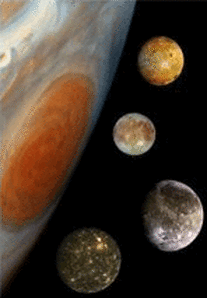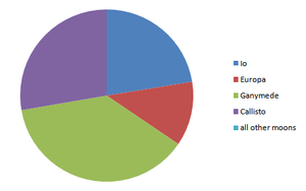Our Solar System
Jupiter Moons

Jupiter has 63 confirmed moons, giving it the largest retinue of moons with reasonably secure orbits of any planet in the Solar System. The most massive of them, the four Galilean moons, which were discovered in 1610 by Galileo Galilei.
Eight of Jupiter's moons are regular satellites, with prograde and nearly circular orbits that are not greatly inclined with respect to Jupiter's equatorial plane. The Galilean satellites are spheroidal in shape, and so would be considered dwarf planets if they were in direct orbit about the Sun. The other four regular satellites are much smaller and closer to Jupiter; these serve as sources of the dust that makes up Jupiter's rings.
Jupiter's other 55 moons are irregular satellites, whose prograde and retrograde orbits are much farther from Jupiter and have high inclinations and eccentricities. These moons were probably captured by Jupiter from solar orbits. There are 13 recently discovered irregular satellites that have not yet been named, plus a 14th whose orbit has not yet been established.
Eight of Jupiter's moons are regular satellites, with prograde and nearly circular orbits that are not greatly inclined with respect to Jupiter's equatorial plane. The Galilean satellites are spheroidal in shape, and so would be considered dwarf planets if they were in direct orbit about the Sun. The other four regular satellites are much smaller and closer to Jupiter; these serve as sources of the dust that makes up Jupiter's rings.
Jupiter's other 55 moons are irregular satellites, whose prograde and retrograde orbits are much farther from Jupiter and have high inclinations and eccentricities. These moons were probably captured by Jupiter from solar orbits. There are 13 recently discovered irregular satellites that have not yet been named, plus a 14th whose orbit has not yet been established.
Galilean Moons

The Galilean moons are by far the largest objects in orbit around Jupiter, with the remaining 59 moons and the rings together comprising just 0.003 percent of the total orbiting mass.
